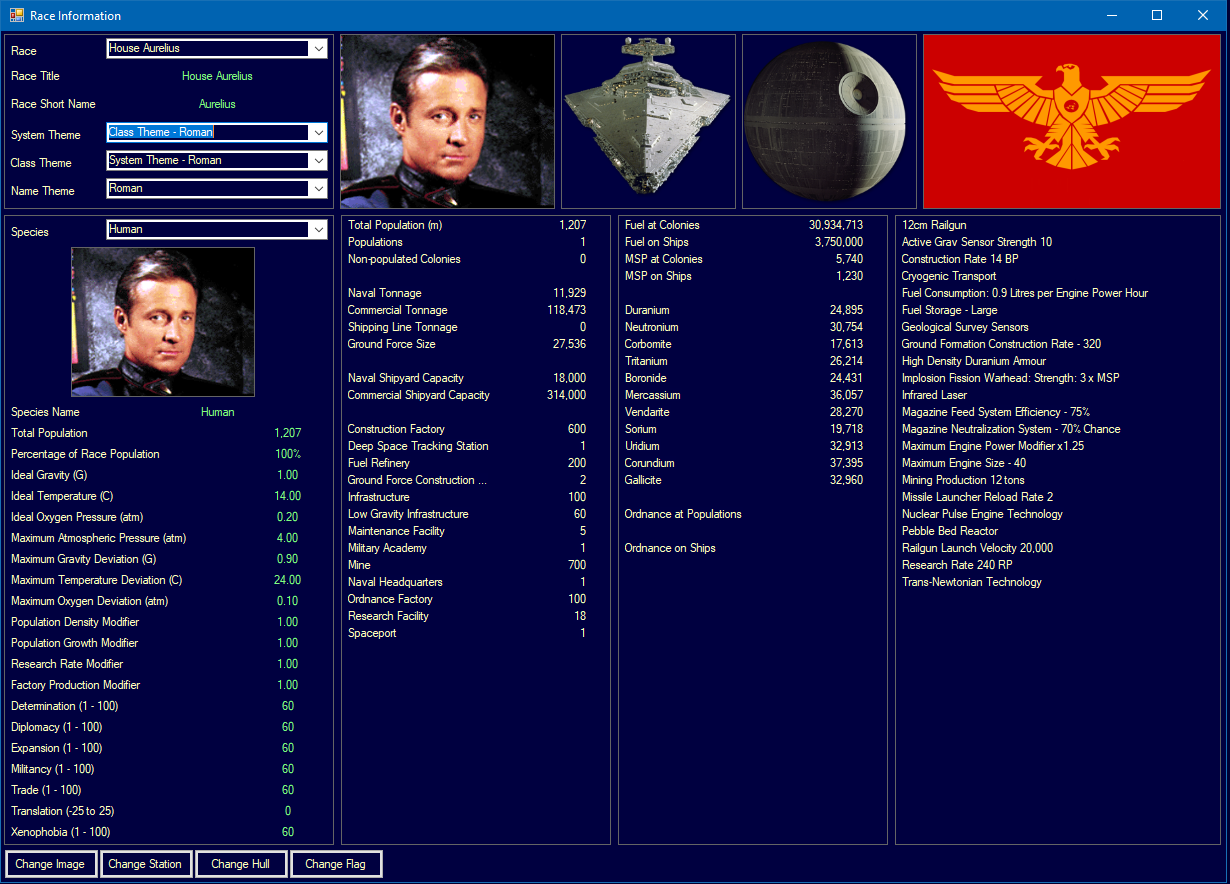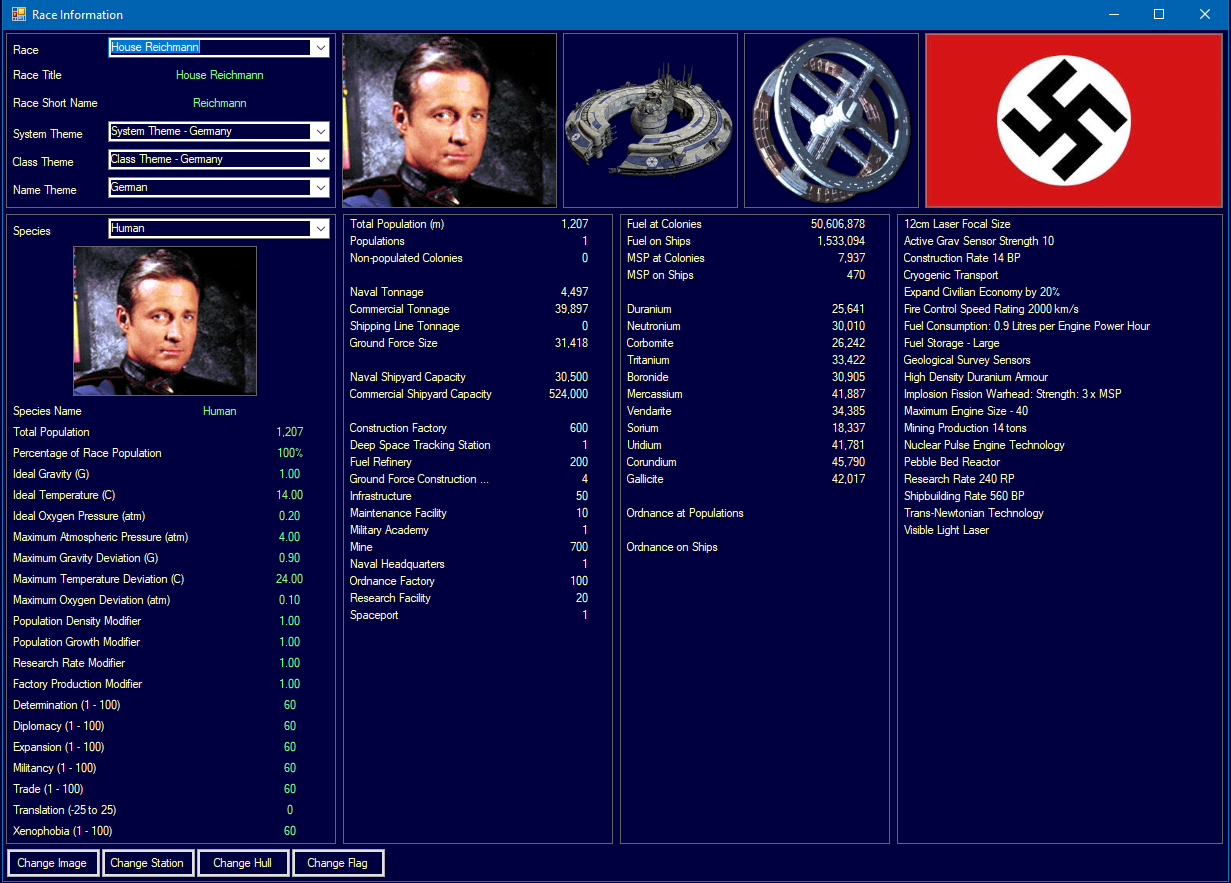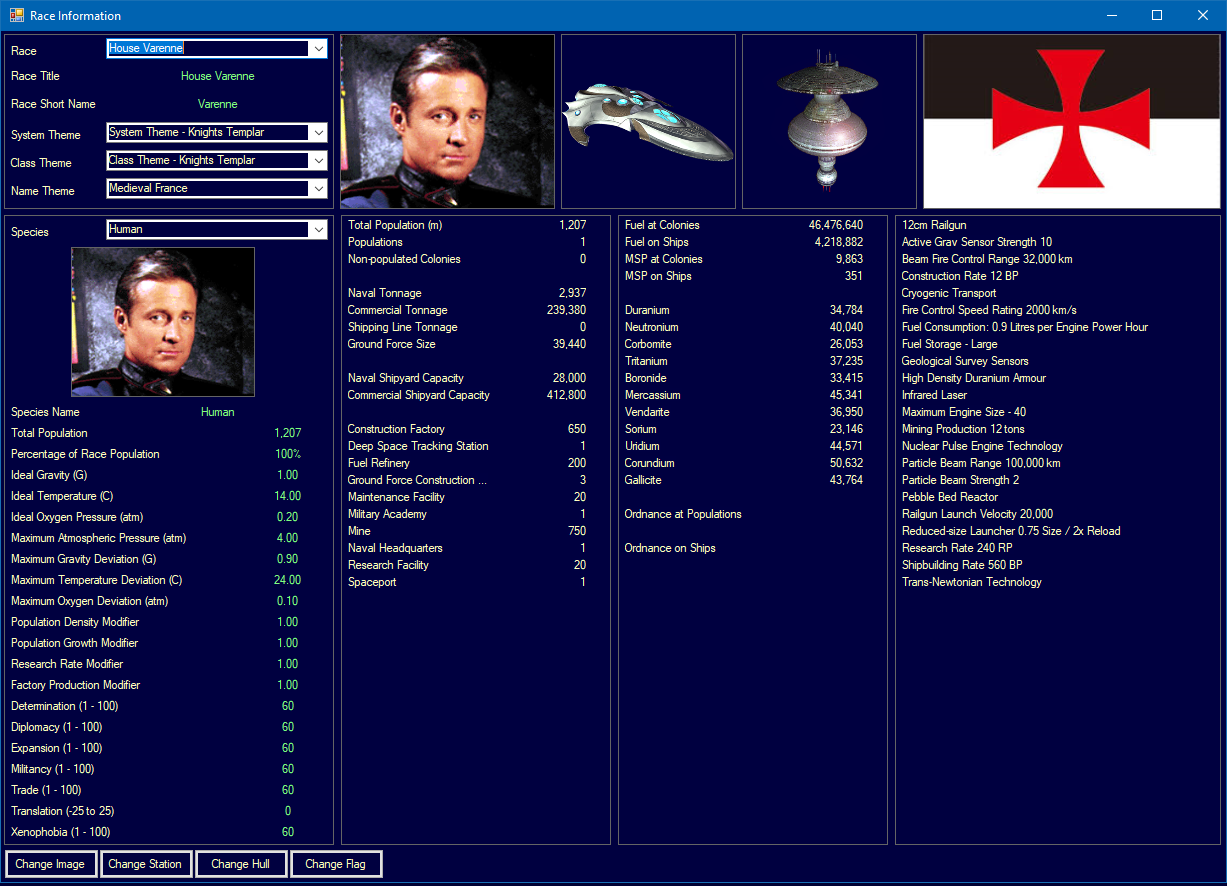Please read the campaign background if you haven't already. The initial reports are going to be very factual as I am concentrating on testing the game at the moment, rather than dedicating a lot of time to background, and the 'conversion from conventional' period is not that interesting. I will start adding more body to the reports once the campaign is fully underway. Note that I just created the houses and started. There was no attempt to create a 'balanced start' or reflect the campaign background in terms of commanders or scientists, although it worked out quite interestingly in that respect. Game Setup January 1st 2401
Five Conventional Player Races
No NPRs at Start
Known Stars
Precursors Active
Planet X Added
Each Race starts with:
1000m Pop, 1600 industry, 16 research factories, 2 shipyards (1 naval, 1 commercial), 5 maintenance facilities, 1 GFCC, 1 DSTS, 1 Military Academy, 1 Naval HQ, 100 Commanders.
The first task of each House was to understand the preliminary data provided by House Varenne and research Trans-Newtonian Technology. House Reichmann was the only house with a scientist who specialised in Construction/Production technology but he was limited to ten research facilities, so it was actually House Fuchida who gained an early edge due to a scientist with a good combination of research skill and administration skill. House Ragnar, a society that valued strength and courage over scientific skill, had a single scientist who could only administer five research facilities. This slow start handicapped House Ragnar throughout the early Trans-Newtonian era.
The Trans-Newtonian Project ScientistsAurelius: MK 25% 10 Labs – 2500 RP
Fuchida: DS 20% 16 Labs – 3840 RP
Ragnar: MK 10% 5 Labs – 1100 RP – only one scientist
Reichmann: CP 20% 10 Labs – 3600 RP.
Varenne: BG 10% 16 Labs – 3520 RP
In early 2401, the leaders of the Houses meeting under the auspices of the Terran League agreed a 20 year non-aggression pact, with a proviso that any aggressive action would be met by all other houses. No one wanted war to weaken them at this critical time in history and even Thor Ragnar saw the benefit of a period of peace to Marshall his forces. Each house began expanding its shipyards even as the new technology was being researched and all except House Ragnar used their conventional factories to construct additional shipyards. Ragnar concentrated on a second military academy to potentially increase its scientific capabilities. House Ragnar received an unexpected boost in February 2402 when the administrative experience gained by its lone scientist allowed him to increase the number of research facilities under his direction to ten, while the chief scientist of House Reichmann increased his own administrative capability from ten to fifteen facilities.
The Trans-Newtonian Era finally began in April 2402 when House Fuchida and House Reichmann made the breakthrough within five days of each other. House Varenne followed in June 2402 and House Aurelius in November. House Ragnar finally completed its project in October 2403, by which time all the other houses were well into the conversion process for their industry. After the construction of its second military academy, House Ragnar finally trained a second scientist in May 2404, with a third following in June and a fourth in July 2405. House Fuchida maintained its early lead with the development of thermal engine technology in August 2406 and was followed by House Varenne in October of the same year. All the houses except Ragnar decided to proceed to nuclear pulse technology before designing their first operational engines. House Ragnar opted to deploy thermal engine technology to avoid a long period in which it had no spacecraft with which to compete with its rivals.
In June 2408, House Fuchida completed the conversion of its industry to Trans-Newtonian technology. The sixteen hundred conventional factories were converted into six hundred construction factories, seven hundred mines, two hundred fuel refineries and one hundred ordnance factories. A multi-year program was initiated to build additional shipyards, research facilities and ground force construction complexes. House Reichmann completed the conversion process in September 2408 with a similar distribution of industry and future plans. House Varenne followed in November 2408, although did not convert any conventional industry to ordnance factories as the military strategists of Varenne had decided their ships would not use missiles. Instead, they planned on a combination of railguns and particle beams, potentially supported by gauss weapons. House Aurelius used a similar conversion strategy to Fuchida and Reichmann, completing the process in January 2410. Due to its slow start, House Ragnar finished the conversion of its factories in June 2411, resulting in six hundred construction factories, seven hundred mines, one hundred and seventy-six hundred fuel refineries and one hundred and twenty-four ordnance factories.
House Aurelius was the first to deploy ground forces, in December 2409, based on the technology underpinning high density duranium and 12cm railguns. The smallest manoeuvre unit was the Cohort, comprising 480 Legionnaires, 24 Light Ballista anti-tank weapons and 24 Scorpio crew-served anti-personnel weapons, plus the headquarters and fire direction units. The plan was to deploy Legions comprising ten cohorts plus supporting weaponry at the Legion level. As of May 2412, eight Cohorts have been produced.
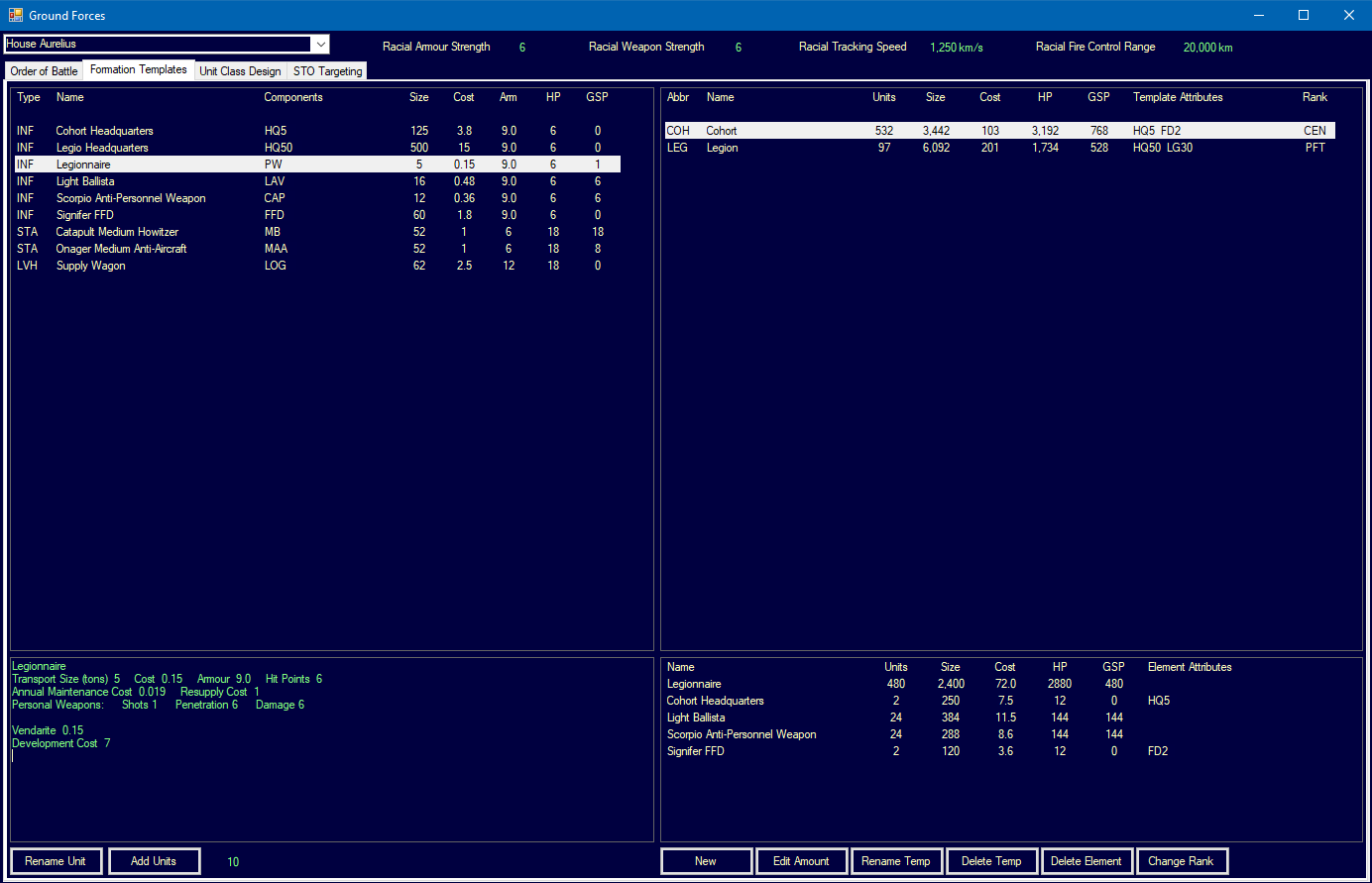
House Varenne produced its first ground formation in February 2410. The Regiment of Foot is intended as a purely defensive formation with more front-line soldiers but less density of supporting weapons than the cohort. Eventually, as the technology becomes available, House Varenne plans to produce heavy armoured formations intended to smash hostile forces while the Foot Regiments hold a defensive line. The headquarters of the the Foot Regiments are more capable than those of the Cohort, enabling its numbers and capability to be increased over time. As of May 2412, eight Regiments of Foot have been produced.
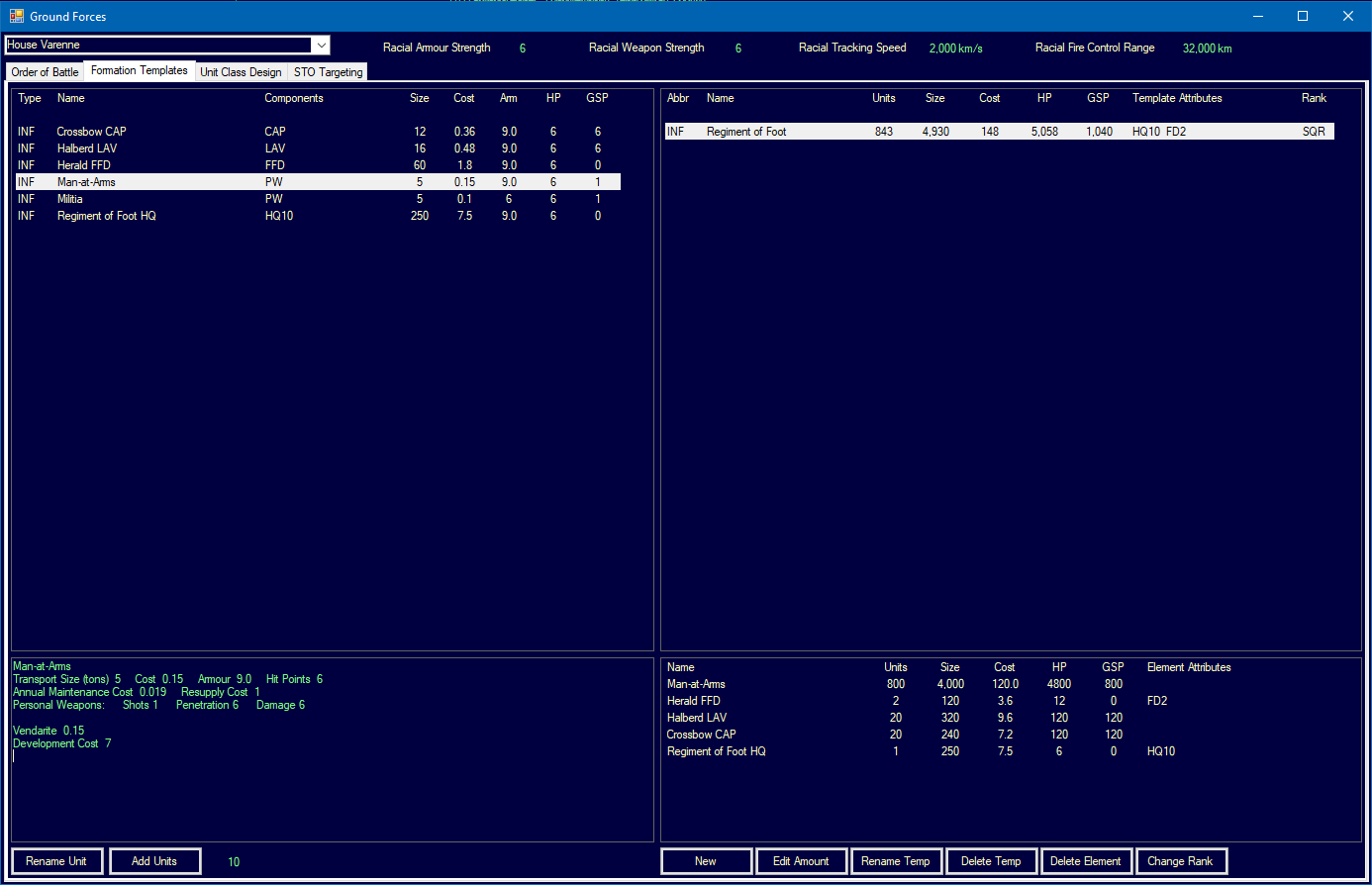
Due to the cultural heritage of House Reichmann, their ground formations and ground officer rank structures are based on the organisation of the Waffen-SS. Despite the atrocities committed during WW2, the Waffen-SS was still a highly effective combat force and functioned very much in line with House Reichmann's ideal of loyalty and dedication to the House above personal ambition. With that in mind, House Reichmann is in the process of creating formations similar to SS Panzer and Panzergrenadier divisions, starting at the company level. The smallest manoeuvre formation is therefore the SS Panzergrenadier Kompanie. For the moment, the Panzergrenadier Kompanie lacks the heavy machine gun equivalent of its historical counterpart, which will be corrected once the technology is available. Historically, a Panzergrenadier Abteiltung, or Battalion, included a headquarters, three Panzergrenadier Kompanie and a Schwere Panzer-Grenadier Kompanie (heavy weapons). House Reichmann has combined the headquarters and the heavy company to form the SS Panzergrenadier Abteiltung, which operates with three attached SS Panzergrenadier Kompanie. For the moment, the headquarters formation lacks engineer support, but that will be added when available. The next step for House Reichmann is to combine three SS Panzergrenadier Abteiltung, plus additional supporting formations into an SS Panzergrenadier Regiment. As of May 2412, House Reichmann has produced eleven SS Panzergrenadier Kompanie and three SS Panzergrenadier Abteiltung.
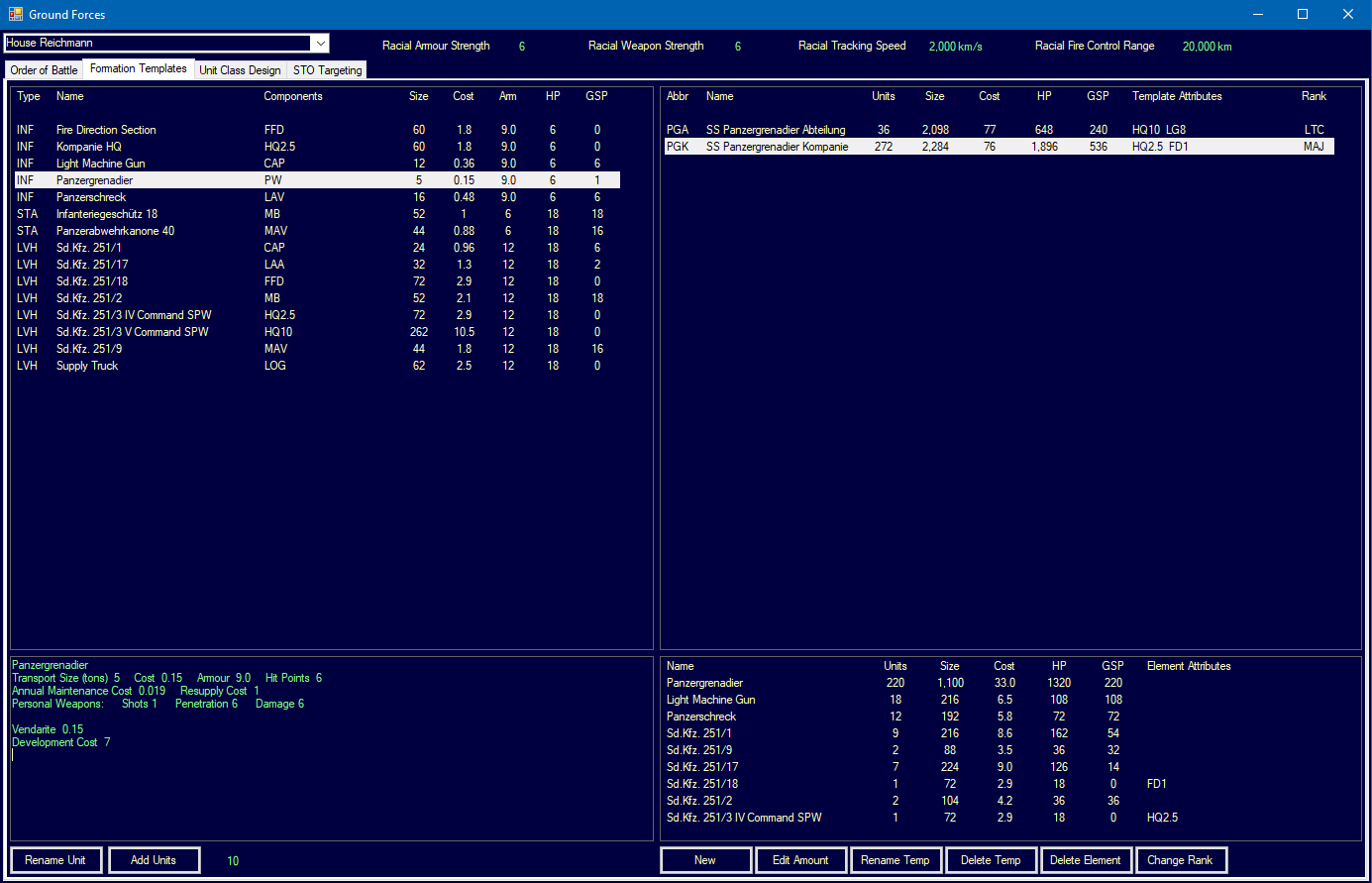
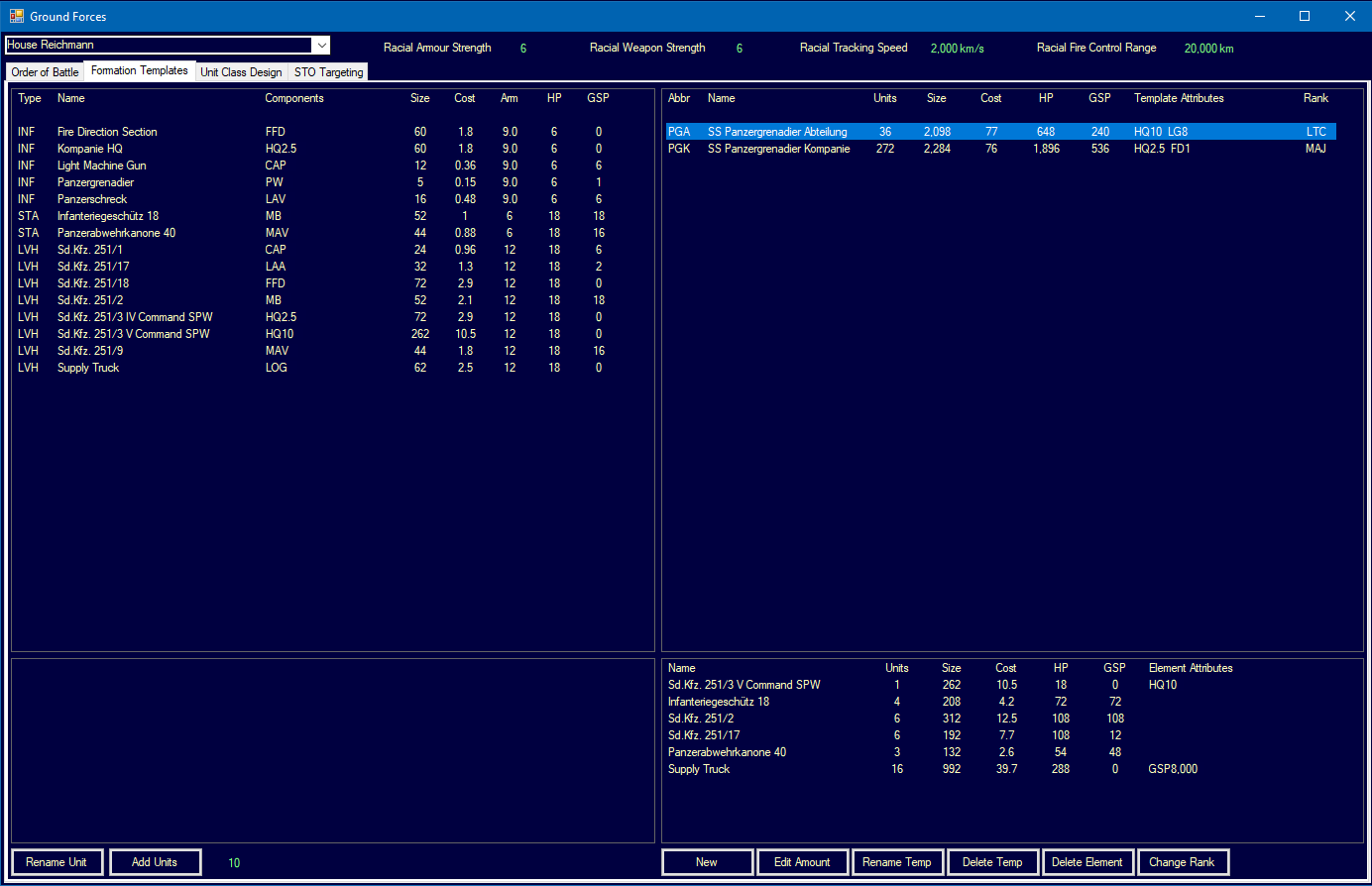
House Ragnar has approached ground combat in a different way. Within Ragnar society the lowest class citizens are known as Thralls, which are virtually slaves with minimal rights. The basic manoeuvre formation of House Ragnar is the Raiding Force, which comprises six hundred Thralls with minimal armour and light personal weapons, three hundred Warriors comparable to Aurelius Legionnaires or Reichmann Panzergrenadiers, and one hundred Berserkers, which are the strongest and most capable soldiers in a warrior society, carrying the equivalent of a personal light machine gun. The primary function of the Thralls is to absorb damage, while the Warriors and especially the Berserkers provide the offensive capability. House Ragnar is falling behind the other Houses in terms of production facilities so only five Raiding Forces have been trained so far.
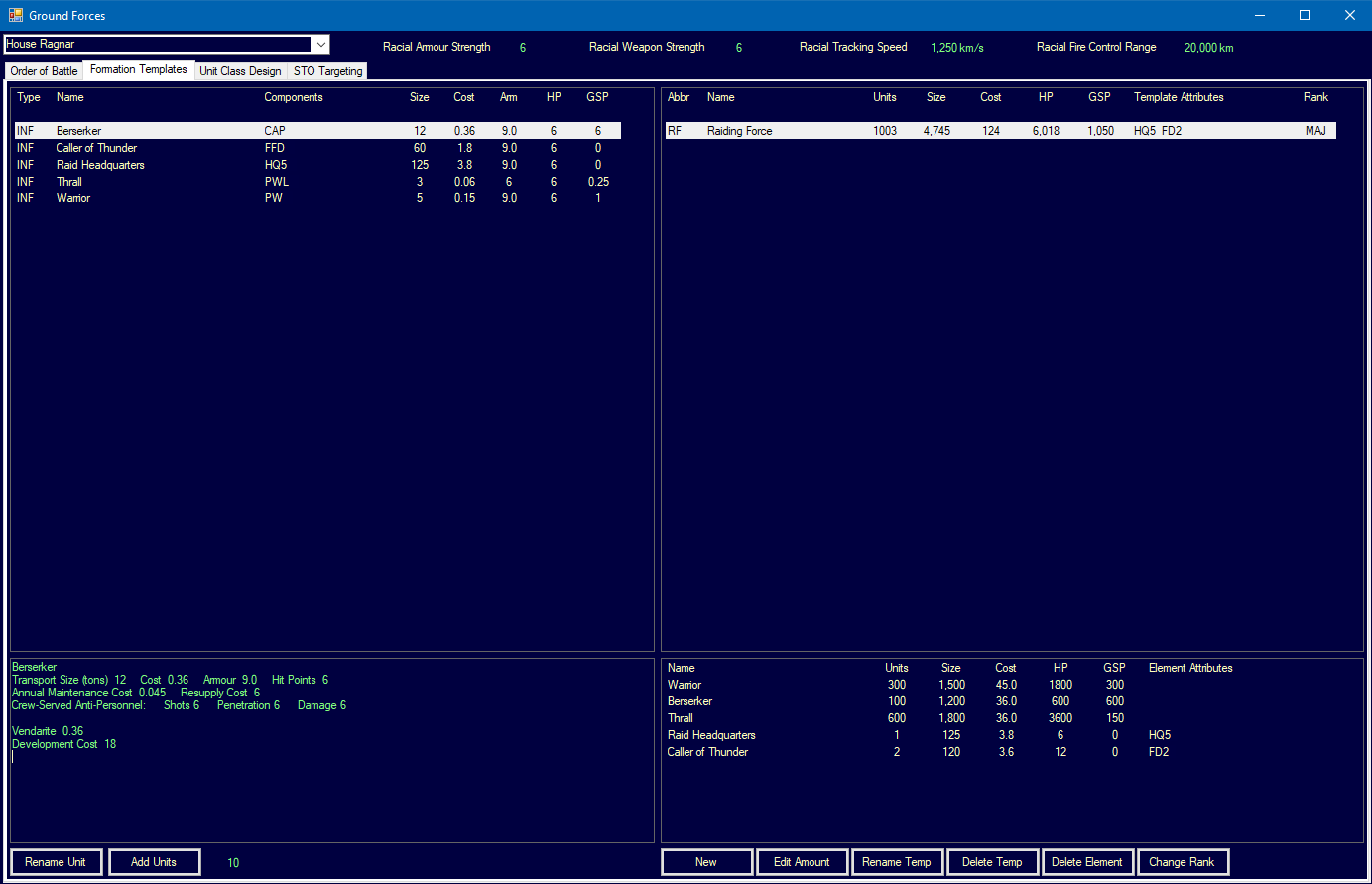
Given its roots in Japanese culture and its imperial approach, it is no surprise that House Fuchida, at least in the short-term, has adopted a similar approach to the Imperial Japanese Army in World War II. The Infantry Battalion of House Fuchida is the largest of the basic House manoeuvre formations and is intended to be formed into Regiments and eventually Divisions. The individual Fuchida Infantryman has weaker armour than his Aurelius, Reichmann or Varenne counterparts, although he has a better weapon than the Ragnar Thrall. While more vulnerable, this also makes the Fuchida Infantryman easier and cheaper to train. The main striking power of the Infantry Battalion comes from its numerous support weapons, including fifty light bombardment weapons and thirty-six light machine guns, plus four medium anti-vehicle weapons. As of May 2412, nine Infantry Battalions have been trained. House Fuchida has long-term plans to build super-heavy armoured forces that will overwhelm its opponents, although that plan will only come to fruition once the necessary technology becomes available.
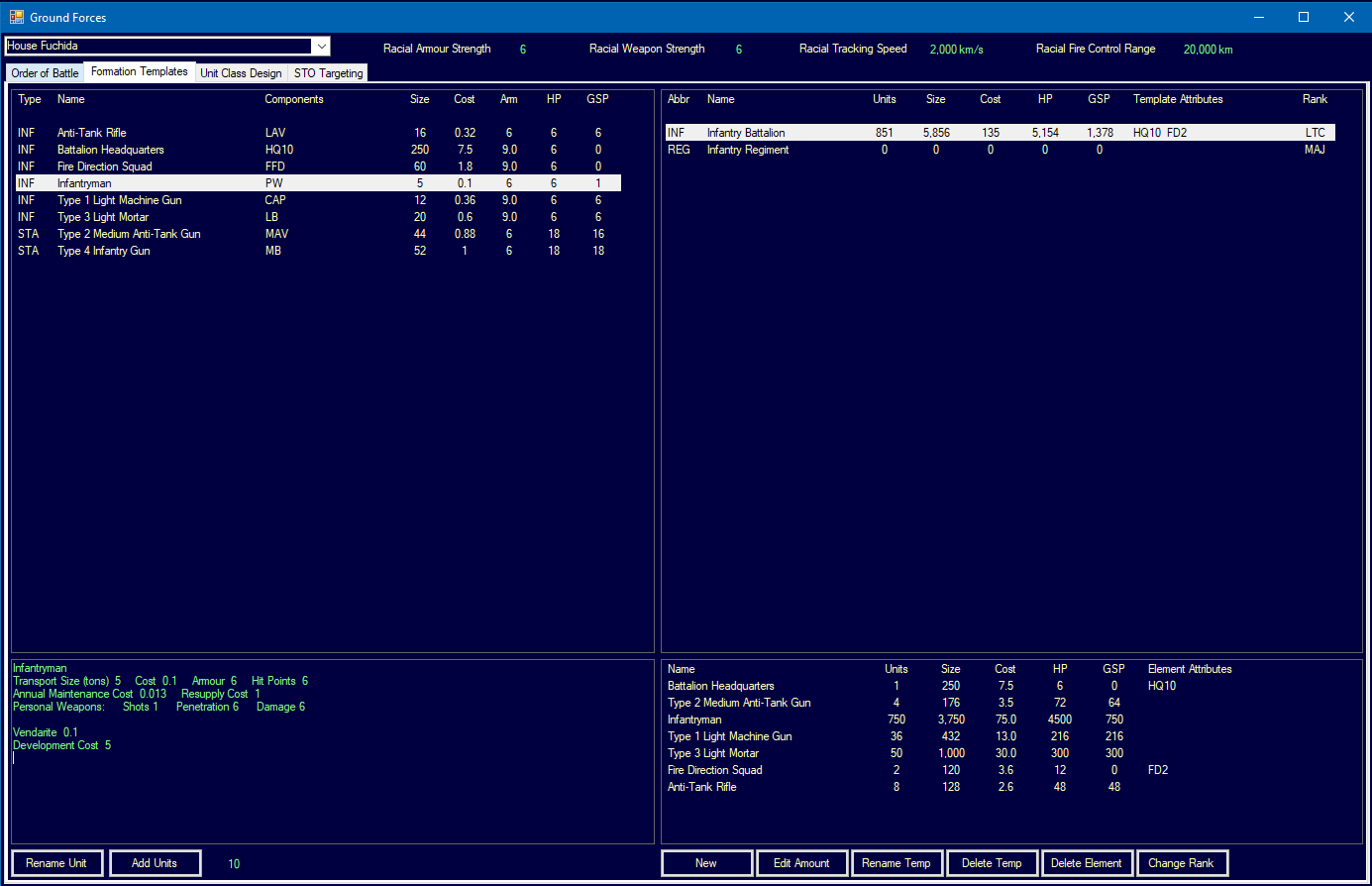
A warning of future shortages arrived in June 2410 when the deposits of Corbomite were exhausted on Earth. Uridium was exhausted in January 2412 and most other minerals are running out. While all the houses have substantial stockpiles, securing new mineral deposits will be a priority in the coming years. In May 2412, the Earth mineral situation is as follows:
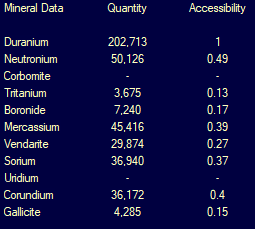
The first Trans-Newtonian spacecraft were launched in February 2411 by House Ragnar as three Hrothgar class freighters emerged from the Hellström Shipbuilding Company orbital shipyard. The decision of House Ragnar to proceed with nuclear thermal engines allowed it to keep pace with its rivals. House Fuchida followed a month later with three Kobyashi Maru class Freighters, so named after fragmented prewar records suggested this was a notable historical ship. As of May 2412, all five houses have freighters in service with similar designs, varying mainly in speed with the Hrothgar noticeably slower than the others.
In August 2411
Raymond Gaucebert, an Aragon class survey ship of House Varenne, became the first geological survey ship constructed and the first Trans-Newtonian spacecraft to leave Earth orbit. On September 1st,
Raymond Gaucebert discovered twelve million tons of accessibility 0.9 Duranium on Mars, along with with large but inaccessible deposits of Corbomite and Uridium. The orbital survey also suggested a minimal chance that a further ground survey might reveal additional mineral deposits. On November 10th, the Varenne survey ship discovered more than three million tons of gaseous Sorium in the atmosphere of Jupiter at 0.7 accessibility. By this point, House Fuchida had three Katsuriki class survey ships in operation, one of which surveyed Saturn on November 10th and found 500,000 tons of 0.9 accessibility Sorium. These discoveries meant any medium-terms needs for Duranium and Sorium could be met within the Sol system, if the Houses were prepared to allow each other access to those minerals. As the other houses launched their geological survey ships, they spread out across the system finding various mineral deposits. While several bodies contained a few thousand tons of minerals at high accessibility, the main discovery by May 2412 was on Europa.

In December 2411, House Fuchida launched the Asama Maru, a 34,000 ton colony ship with a capacity of 70,000. Houses Aurelius, Reichmann and Varenne all have colony ships under construction, with Varenne the closest to completion, while Ragnar has yet to lay down a colony ship due to a lack of shipyard space. House Fuchida used its colony ship and six freighters to establish colonies on both Mars and Europa, which as of May 2412 have populations of 340,000 and 120,000 respectively. With the opening of the solar system to colonisation by House Fuchida, a shipping line was formed by the one of the Zaibatsu, (a Fuchidan term for an industrial conglomerate). Two ships, a colony ship and a freighter, have so far been launched by the Toshishai Colony Corporation and they have made the first runs to Mars and Europa.
The current ship strengths of the five Houses are as follows:
House Aurelius3x FT Hercules
3x GEO Odysseus
Note that House Aurelius uses Greek names for unarmed ships, reserving Roman names for warships.
House Fuchida6x FT Kobyashi Maru
1x CS Asama Maru
3x GEO Katsuriki
House Ragnar6x FT Hrothgar
3x GEO Tyr
House Reichmann1x FT Atlantis
1x GEO Kormoran
House Varenne6x FT Poitiers
1x GEO Aragon
House Summaries